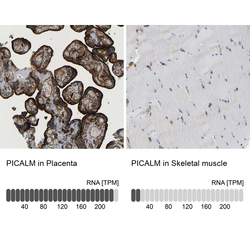Antibody data
- Antibody Data
- Antigen structure
- References [6]
- Comments [0]
- Validations
- Immunohistochemistry [1]
Submit
Validation data
Reference
Comment
Report error
- Product number
- HPA019061 - Provider product page

- Provider
- Atlas Antibodies
- Proper citation
- Atlas Antibodies Cat#HPA019061, RRID:AB_1855362
- Product name
- Anti-PICALM
- Antibody type
- Polyclonal
- Description
- Polyclonal Antibody against Human PICALM, Gene description: phosphatidylinositol binding clathrin assembly protein, Alternative Gene Names: CALM, CLTH, Validated applications: WB, IHC, Uniprot ID: Q13492, Storage: Store at +4°C for short term storage. Long time storage is recommended at -20°C.
- Reactivity
- Human, Mouse, Rat
- Host
- Rabbit
- Conjugate
- Unconjugated
- Isotype
- IgG
- Vial size
- 100 µl
- Concentration
- 0.2 mg/ml
- Storage
- Store at +4°C for short term storage. Long time storage is recommended at -20°C.
- Handling
- The antibody solution should be gently mixed before use.
Submitted references
Anti-malaria drug artesunate prevents development of amyloid-β pathology in mice by upregulating PICALM at the blood-brain barrier
Selective endocytosis of Ca 2+ -permeable AMPARs by the Alzheimer’s disease risk factor CALM bidirectionally controls synaptic plasticity
Acute inhibition of OGA sex-dependently alters the networks associated with bioenergetics, autophagy, and neurodegeneration
Central role for PICALM in amyloid-β blood-brain barrier transcytosis and clearance
Modulation of PICALM Levels Perturbs Cellular Cholesterol Homeostasis
Duan J, Kozlova A, Zhang S, Sudwards A, Zhang H, Smirnou S, Sun X, Stephenson K, Zhao X, Jamison B, Ponnusamy M, He X, Pang Z, Sanders A, Bellen H, Thinakaran G
2024
2024
Anti-malaria drug artesunate prevents development of amyloid-β pathology in mice by upregulating PICALM at the blood-brain barrier
Kisler K, Sagare A, Lazic D, Bazzi S, Lawson E, Hsu C, Wang Y, Ramanathan A, Nelson A, Zhao Z, Zlokovic B
Molecular Neurodegeneration 2023;18(1)
Molecular Neurodegeneration 2023;18(1)
Selective endocytosis of Ca 2+ -permeable AMPARs by the Alzheimer’s disease risk factor CALM bidirectionally controls synaptic plasticity
Azarnia Tehran D, Kochlamazashvili G, Pampaloni N, Sposini S, Shergill J, Lehmann M, Pashkova N, Schmidt C, Löwe D, Napieczynska H, Heuser A, Plested A, Perrais D, Piper R, Haucke V, Maritzen T
Science Advances 2022;8(21)
Science Advances 2022;8(21)
Acute inhibition of OGA sex-dependently alters the networks associated with bioenergetics, autophagy, and neurodegeneration
Huynh V, Benavides G, Johnson M, Ouyang X, Chacko B, Osuma E, Mueller T, Chatham J, Darley-Usmar V, Zhang J
Molecular Brain 2022;15(1)
Molecular Brain 2022;15(1)
Central role for PICALM in amyloid-β blood-brain barrier transcytosis and clearance
Zhao Z, Sagare A, Ma Q, Halliday M, Kong P, Kisler K, Winkler E, Ramanathan A, Kanekiyo T, Bu G, Owens N, Rege S, Si G, Ahuja A, Zhu D, Miller C, Schneider J, Maeda M, Maeda T, Sugawara T, Ichida J, Zlokovic B
Nature Neuroscience 2015;18(7):978-987
Nature Neuroscience 2015;18(7):978-987
Modulation of PICALM Levels Perturbs Cellular Cholesterol Homeostasis
Miyamoto S, Mercer J, Argus J, Crabtree D, Keenan M, Wilks M, Chi J, Bensinger S, Lavau C, Wechsler D
PLOS ONE 2015;10(6):e0129776
PLOS ONE 2015;10(6):e0129776
No comments: Submit comment
Supportive validation
- Submitted by
- Atlas Antibodies (provider)
- Enhanced method
- Orthogonal validation
- Main image

- Experimental details
- Immunohistochemistry analysis in human placenta and skeletal muscle tissues using HPA019061 antibody. Corresponding PICALM RNA-seq data are presented for the same tissues.
- Sample type
- Human
- Protocol
- Protocol
 Explore
Explore Validate
Validate Learn
Learn Western blot
Western blot Immunohistochemistry
Immunohistochemistry